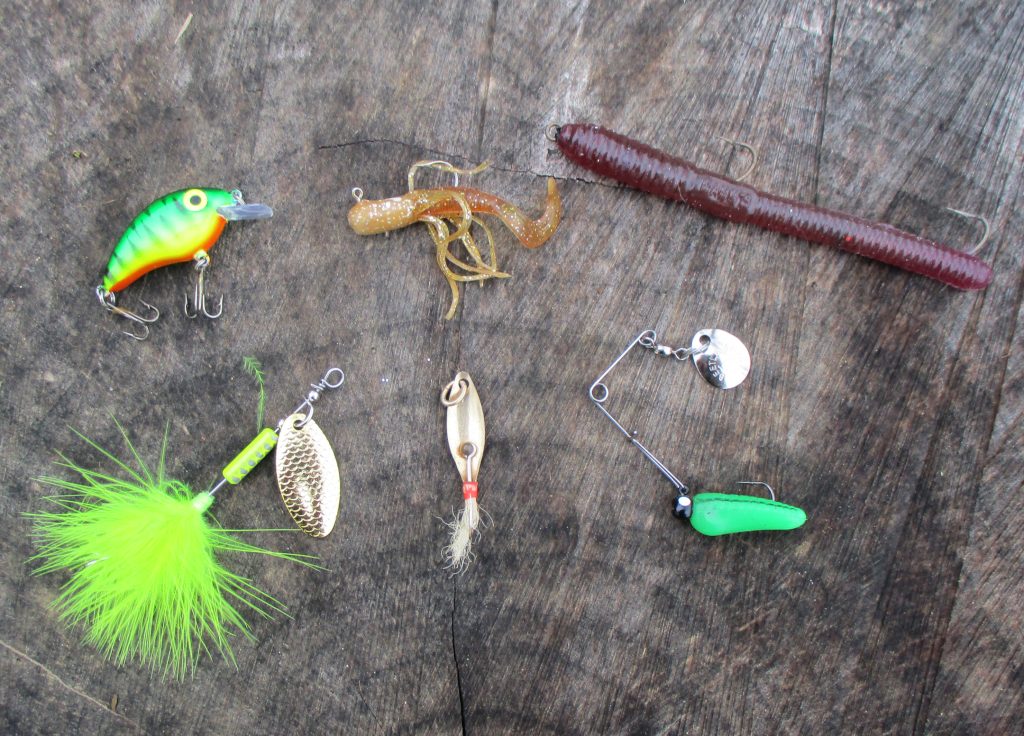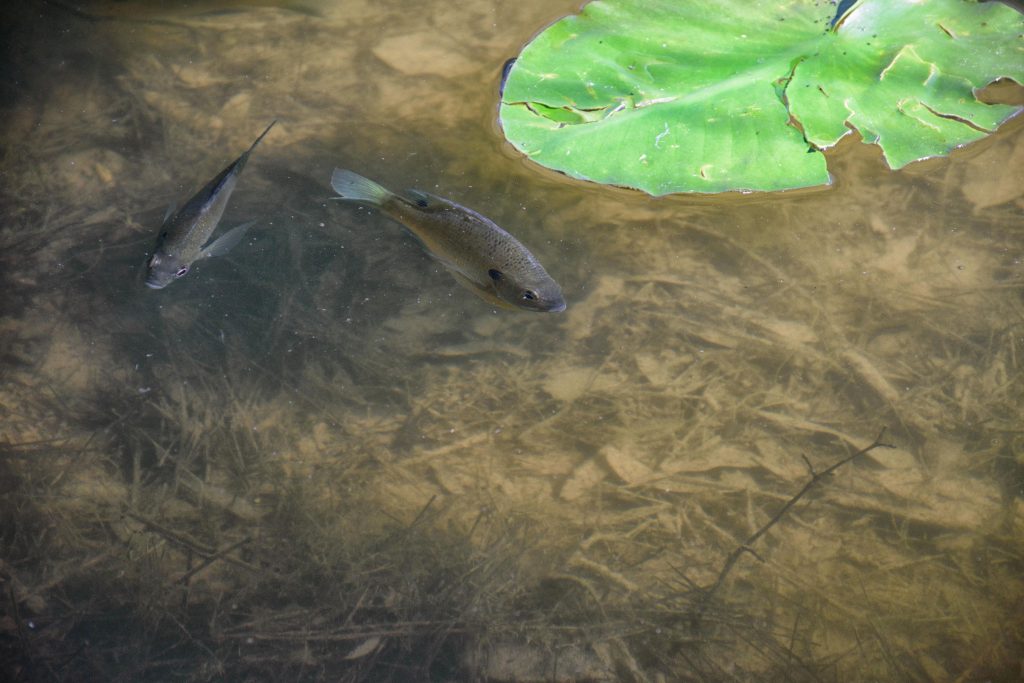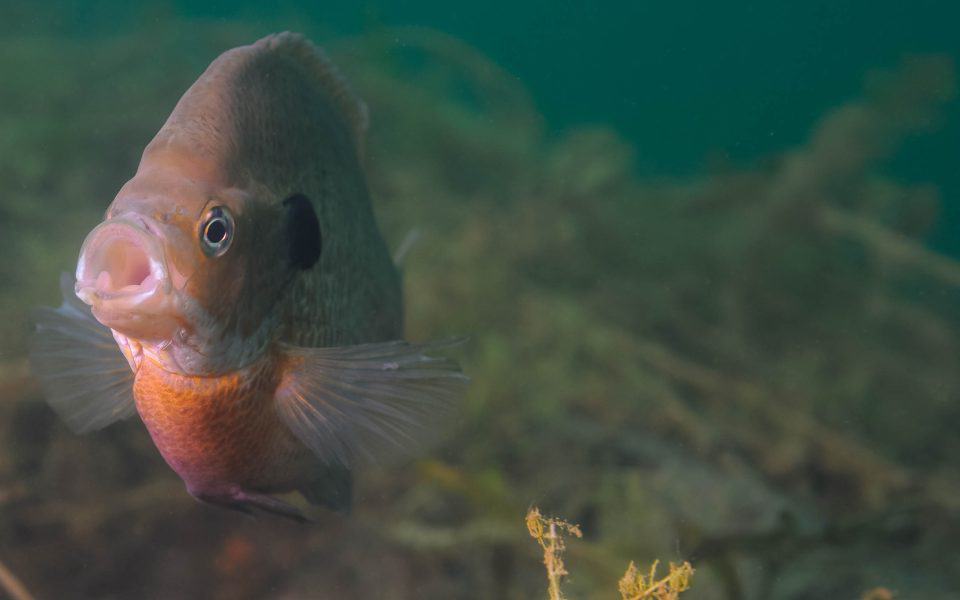When summer slips in with its hot, muggy days, some anglers choose the challenge of largemouth, fishing the surface feed in the shallows at dawn and working plastic worms and jigs over deep structure during midday. Others head for the cool waters of trout streams, fishing hatches when mayflies emerge, terrestrials when they don’t, to catch browns, brookies, and rainbows.
A substantial group of anglers turn to a different quarry, one that’s more willing to bite on a sultry summer day than either bass or trout — the motley crew of panfish. This varied group of fish includes crappies, bluegills, rock bass, white bass, yellow perch, pumpkinseeds, and redbreast sunfish. These species provide bent rods almost any day on the water, and a colorful stringer at day’s end. Rare is the outing when one, or usually several of these overlooked species is not on a feeding spree.
Besides steady action, here’s another reward: there’s a reason they call them “pan” fish. They’re delicious deep-fried, baked, or sautéed in lemon, butter, and garlic.
Here are some tips that will help you in catching summer panfish in rivers, streams, lakes, and ponds. They’re sure to brighten a summer day on the water and a great activity for kids.
A great time to fish for bluegills, shellcrackers, and pumpkinseeds is during the full moon period. Sunfish often spawn at this time. Even if they don’t, they tend to feed aggressively during this phase. From my experience the next best is the new moon.

Gerald Almy
Sponge rubber flies are great for panfish either spawning or feeding in the shallows. But if the legs on your flies are too long, they often tangle on the hook. To fix that, trim them back so they only extend about one-quarter to one-half inch from the sides. This will keep them from tangling and ensure that the fish gets the hook in its mouth — not just the long dangling legs.
“Shellcracker” is another name for the redear sunfish. The nickname comes from this fish’s fondness for eating mollusks, particularly snails. Look for redears around submerged stumps, where they root for these mollusks, which form an important part of their diet, and occasionally they’ll nab a slow-crawled nymph. The best bait is red wrigglers or earthworms on a size #6 or #8 hook.
After the spawn, search for bluegills and other sunfish in water 8 to 20 feet deep. Areas with sunken brush, weed beds, or sharp bottom contours such as a drop-off or point can produce some fast-paced action in this post-spawn period. Probe these spots with a stubby-tailed 1/16 or 1/32-ounce plastic grub. Cast out, let the grub sink, and retrieve it ever so slowly, just above the bottom. If strikes are slow in coming, add occasional pauses so the jig drops to the bottom. And watch out — you might latch onto a big largemouth instead of a 5-ounce “bream.”

Judy Darby
Try chumming to improve your catch. Anchor out over likely structure and sprinkle cornmeal, crumpled up eggshells, or oatmeal around the boat every few minutes. Soon minnows will begin to gather to feed on the chum, and they, in turn, will attract a variety of panfish, particularly, crappies and perch.
Bluegills spawn several times during late spring and summer. If you miss the first breeding period, hit the water one month later and search for the bedding fish in one to five foot depths in protected coves and bays. Look for circular depressions in the sandy or gravel bottoms.
Look for redbreasts (Lepomis auritus) in rivers where the current eases into eddies and pools, and near slow undercut banks, rather than out in faster riffles and rapids. They’re particularly fond of spinnerbaits and traditional in-line spinners crawled back slow and deep. They’ll also nab wet flies, poppers, and sponge-rubber spiders presented with a fly rod. Bait fishermen do well with crickets and worms on these feisty, brightly colored fish.
Excellent catches of sunfish can be made with trout flies — and they don’t have to be fancy. Many fishermen save flies that trout have chewed up and mangled a bit for second-hand use on panfish. Try offerings such as the Royal Wulff, Adams, and Elk Hair Caddis. Terrestrial patterns like ants, beetles, and grasshoppers are especially productive. Work them with gentle twitches.
Nymphs such as the Hare’s Ear or Pheasant Tail work especially well when panfish are holding deep. Wet flies such as the Black Gnat, Woolly Worm, or McGinty are also deadly. Sizes 8 to14 are best for the small mouths most panfish have.
When sunfish aren’t cooperating on the surface with sponge rubber spiders, try adding a small split shot 12 inches up the leader or switching to a sinking tip fly line. You can also add wire before attaching the body and legs if you tie your own. Strip the fly back with six-inch tugs or try a steady hand-twist retrieve. This is especially effective during midday when fish often move to deeper water. When fishing lakes, concentrate on locations like creek inlets, points, coves, humps, rock piles, flats, drop-offs, weed beds, fallen trees, brush piles, and docks.

M Huston
A good way to catch spawning shellcrackers is to pole or use an electric motor to move through shallow water, preferably with a sandy bottom, searching for the oval beds the fish make for breeding. If you see fish and they swim off, note the location and come back. They’ll return in a short while. When they do, toss a red wriggler or earthworm on a size 6 or 8 long-shank hook with a small split shot into the bed. It won’t be long before a redear swoops in and grabs the worm.
If you see white bass breaking on the surface but they stop before you can get to them, try vertical jigging. The fish are probably still there but feeding at a lower level. Drop a one-quarter to one-half ounce slab spoon (such as a Hopkins) down 10 to 20 feet, then lift it up and down with sharp one to two-foot twitches of the rod tip. Watch carefully for the line to move sideways or stop falling, indicting a strike. Fish will typically nail the spoon as it flutters down like a wounded minnow.
A good way to produce double hookups on white bass is to have one angler keep a lure or streamer ready to put into action when the other person in the boat hooks into a fish. As the bass struggles against the hook, the second angler should cast as close to the fighting fish as possible. Since whites are schooling fish, several other bass will often be swimming close to the hooked one and grab the second lure or fly when it’s pulled past them.
To locate white bass in a lake new to you, try trolling. Top offerings include jigs, small diving crankbaits, and silver spoons. Troll areas such as humps, points, sharp bottom contour changes, and creek mouths. Pay special attention to any spots where baitfish show on the depth finder, probing depths from 8 to 24 feet. Throw out a marker buoy or enter it into your GPS when you locate fish and troll through that area again, or anchor near and cast to the quarry.
Rock bass are a great quarry to turn to when smallmouths prove hard to catch. They often inhabit the same rivers and sometimes are found in rocky lakes. Try stone piles, points, logjams, and the edges of weeds using silver and gold spinners, grubs, spoons, and spinnerbaits. Fly anglers do very well using popping bugs, nymphs, dark-colored wet flies and compact streamers. Keep retrieves slow. These brassy-olive fish don’t like to move too quickly.
Don’t overlook shoreline cover when casting for rock bass. These fish love to hang just inches from an overhanging branch or rock near the stream’s edge. Make an accurate cast and an instant strike is almost guaranteed.
For yellow perch, bottom bouncing with live minnows is hard to beat. Rig a one-ounce dipsey or bank sinker on the bottom with two droppers 12 and 24 inches above it baited with live shiners or creek minnows. You can drift fish in light winds, slowly troll, or cast and retrieve this offering near weed beds, rocky areas, and channel drop-offs. Once you catch a fish, drop a marker buoy and focus on that area. These are schooling fish; there should be more around. This is also a proven tactic for summer crappies! However, the crappies could be anywhere in the water column, and are often suspended.

Fred Bul
A great way to take crappies and white bass during hot weather is fishing at night under lantern lights. The illumination attracts small insects and they in turn draw in minnows which entice the panfish to feed. You can use live minnows, slab spoons, small grubs, or spinnerbaits to catch these fish.
If you run out of minnows when fishing for crappies, white perch, or yellow perch, try this trick. Slice a thin tapered strip about 1-2 inches long and l/2-inch wide out of the belly of a fish you’ve previously caught and kept on ice. This offering has real fish scent and the appearance of a minnow. Make sure this is legal in your state. Using gamefish as bait, even if it’s just a piece, is illegal in a number of states.
Most panfish are suckers for a twitched popper early and late on hot sunny summer days. Work a small cork or balsa popper with a feather tail very close to weeds, stumps, and along shore, twitching it sporadically.

Gerald Almy
When you’re not sure whether to fish on top or beneath the surface for sunfish, try both presentations at once (where legal). Tie on a popper, then attach an 18-inch section of 4-pound test monofilament to the eyelet or the bend of the hook. Knot a small nymph or wet fly to that. The surface lure will draw the fish’s attention, but many pumpkinseeds, shellcrackers, and bluegills will nab the trailing fly which looks like an easier meal.
When casting, go with light or ultralight spin tackle for panfish. The lower part of the rod, though, should have some backbone with most of the bend or flex concentrated in the top third of the rod. This allows you to set the hook firmly, but not pull the lure out of the fish’s mouth.
Try small silver-colored crankbaits that dive 8 to14 feet for white bass and white perch. Work points, bars, submerged islands, and sharp river channel drop-offs. Cast and retrieve slowly. Also watch for white bass breaking on the surface crashing into schools of shiners or shad at the same time. Keep another outfit rigged with a plastic-tailed jig or small popper to try for those surface-feeders.
Fly fishing tackle for redbreasts, rock bass, sunfish and other small species typically means a 5 to 7-weight outfit. For even more fun, scale down to a 3 or 4 weight rod. Those light outfits will make catching even a half-pound panfish a real thrill!
Join our weekly newsletter or subscribe to GameKeepers Magazine.
Your source for information, equipment, know-how, deals and discounts to help you get the most from every hard-earned moment in the field.









